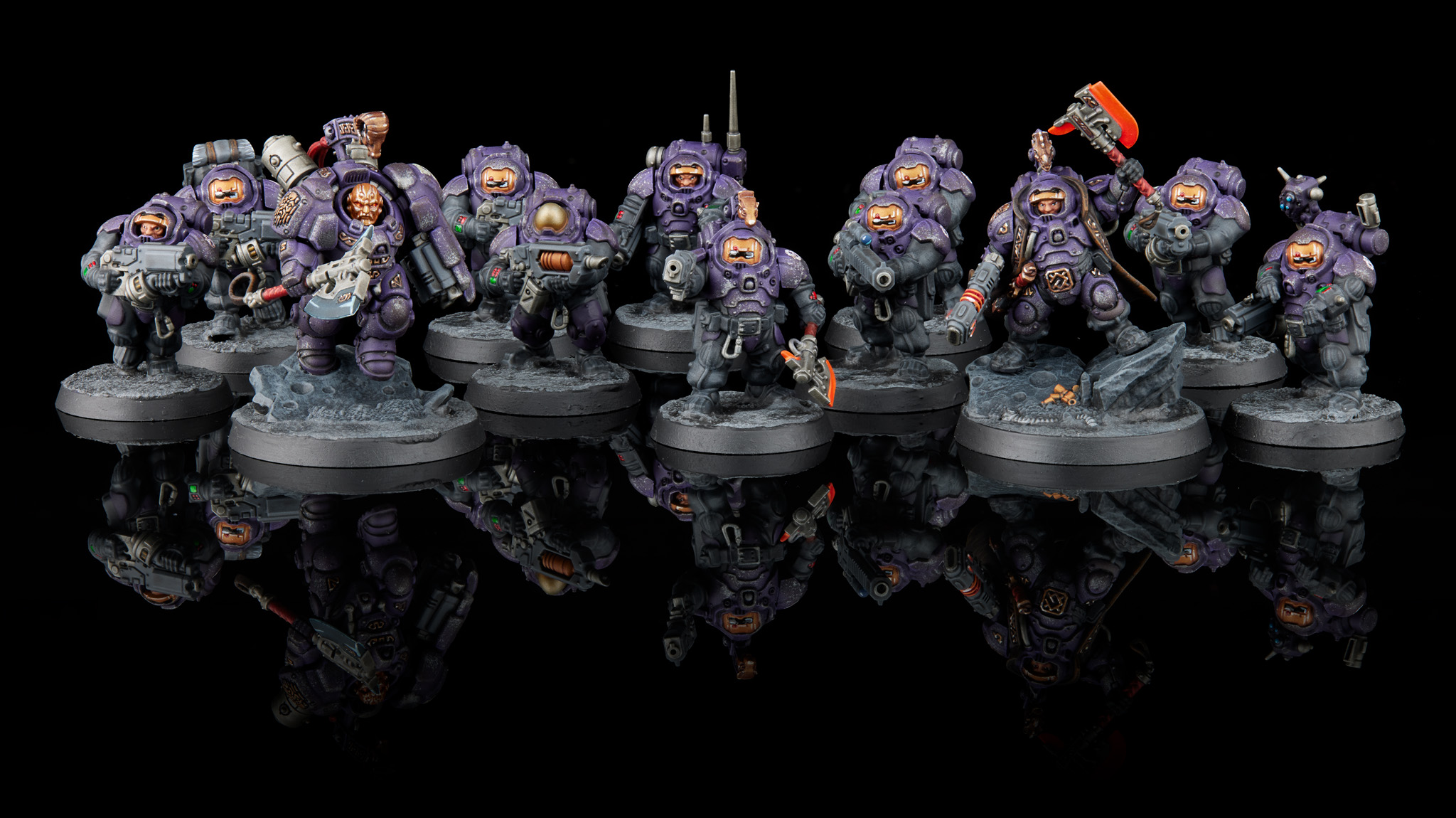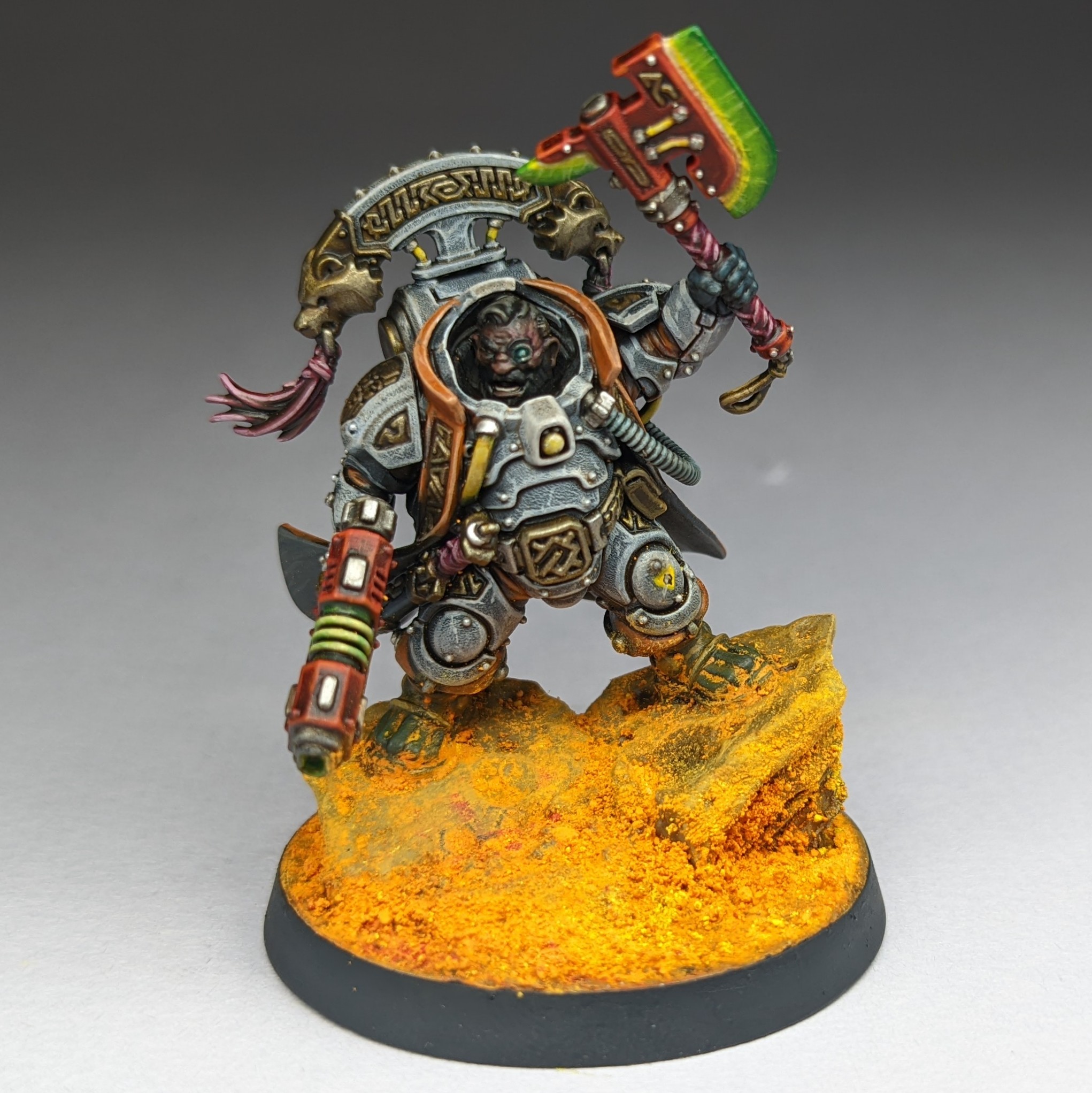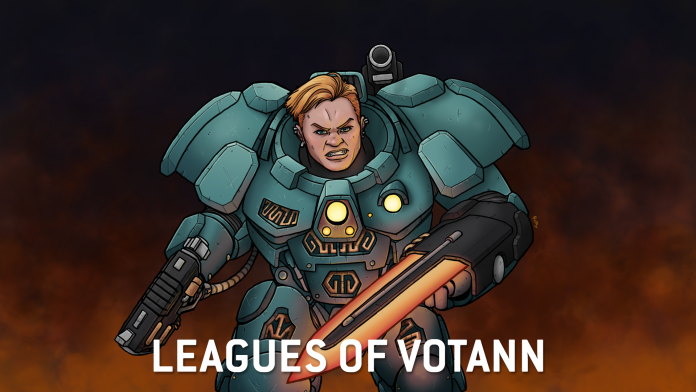While other factions have to wait for a new Codex to drop in the next two years, Crusade Christmas has come early for the Leagues of Votann, and they’ve received updated tenth edition Crusade rules in White Dwarf #503 (August 2024). This issue features updated rules for the Kin and serves as a stopgap until their Codex presumably drops (though we sincerely hope this doesn’t portend a very late release for them) – but are the rules any good? In this review we’ll talk about what’s here, what’s changed, and whether you should pick the rules up if you’re playing Votann.
Spoiler: You should, because this is huge improvement on “not having rules at all.”
The Basics
These rules more or less serve as an update on the 9th edition rules. So if you bought the Leagues of Votann Codex back then, a lot of this will look familiar to you – Grudges, Acquisitions, it’s all here. The rules for how these operate have been changed a bit, primarily to reflect changes to tenth edition datasheets and rules – Grudges now use a different mechanic, for example.
Overall, the flavor here is twofold: Record grudges against the enemy units that killed your guys, and collect a big pile of points representing various doodads from around the galaxy to trade and smelt into upgrades.
![]()
Grudges
One of the two core mechanics here is Grudges. Each time one of your Votann units is destroyed by an enemy and fails an Out of Action test, put a note down on that Crusade card, just noting the enemy faction. That’s going to represent your eternal hatred toward that faction. At the start of each battle, for every unit in your army holding a grudge against the opponent’s faction, roll a D6. On a 6, you can put a Grudge token on an enemy unit. These are the same as Judgment tokens but they only be used by units holding a grudge against that faction. For each 1, put a Grudge token on your unit and that unit can’t be targeted by Stratagems. These fall off once that unit shoots or fights. If any units in an attached group are carrying grudges, then they’re all carrying those grudges.
When you attack a unit with Grudge tokens, if your unit is harboring a grudge, then non-COG models in the unit re-roll hit rolls of 1, or all hit rolls if they have 3 Grudge tokens. Units holding a Grudge can’t Fall Back if they’re within engagement range of a unit from the grudge faction.
At the end of the battle, each unit that survived and killed 3+ enemy units loses its grudges.
This is very similar to the 9th edition crusade rules, with two big exceptions: You no longer lose CP for 1s rolled, and being a unit harboring a grudge doesn’t stop you from doing Actions. This is a bit of a shame, and likely got dropped out because the core tenth edition rules don’t have actions. Otherwise, these are solid, and we like the idea of keeping a book of grudges as you play. Though we have to ask: Why wait to play Votann to do this?
Kindred Acquisitions
The other half of Votann Crusade rules is Kindred Acquisitions, the process by which you harvest a bunch of raw materials as you cavort around the galaxy, hauling them back home to trade in for cool Crusade Effects. As with the Codex, there are four resources you can acquire:
- Raw Minerals
- Biomatter
- Energy Sources
- Galactic Intel
After each battle you randomly determine which type you gained from that battle – roll a D6 and on a 5+ you get to pick, a 1-4 get you the type listed above – and the amount you gain is random and dependent on the size of the battle you fought, ranging from D6x5 (Combat Patrol) to 3D6x10 (Onslaught). On top of that, after each battle you roll a D6 and on a 6+ you gain a Rare Resource (roll to determine the type of this using the same table). Rare Resources have their own use or can be converted into 50 regular resources of their type.
Resources are used to purchase Kindred Assets, special army-wide upgrades. Your army can have one of each Kindred Asset, and those assets can be further upgraded using a combination of Rare and standard resources to generate an even better effect. That said, Kindred Assets can also be lost – if you have four or more of them then after each battle after you get your resources (and before you spend them), you roll a D6. On a 1 one of your assets is randomly deactivated – you have to spend half its cost to reactivate it.

Kindred Assets
There are six Kindred Assets and these are functionally identical to the ones first introduced in Codex: Leagues of Votann back in 9th edition. Most of them super-charge your resource gathering, giving you more materials of a certain type or letting you choose which type you get, though two give you RP discounts on specific Requisitions. Where they really get interesting is in the Upgraded Effects – Maintain Core Systems for example lets you spend Galactic Intel to give one of your GRIMNYR a Battle Honour, while Supply the Guilds lets you spend Rare Energy Sources to hand out Weapon Modifications.
It’s cool stuff but it does have a bit of an issue in that you can easily generate a ton of extra upgrades this way, letting you fast track upgrades for your units in a way that few other factions can match, even with their Crusade rules. Votann were an issue in this regard in 9th, and alongside some very pushed rules in their Codex made for some oppressive times in Crusade. As a GM it’s worth keeping an eye on this.
Agendas
All four Agendas have carried over from 9th Edition but with minor tweaks and adjustments to fit within the current edition.
No Effort Wasted remains essentially the same, keeping a tally for each time your unit destroys an enemy unit that has judgement tokens. One Judgement token is worth one tally, and two is worth two tally points. At the end of the battle reduce everyone’s tally by one for each enemy unit with judgement tokens still on the board (or embarked on a vehicle Beanith: Loophole spotted and closed). Each unit then gains that much XP equal to its No Effort Wasted tally to a maximum of three.
Priority Acquisition remains your goto Agenda for a fairly easy gimme Agenda with an increased chance at gaining a Rare Resource along with 3XP for your favourite unit carrying around a pan spectral scanner. Your opponent places an objective marker anywhere on the field outside their own deployment zone and your job to wander over there, tell any enemy to bugger off and then give up shooting and charging for that turn. Doing that nets you the 3XP. If this unit survives the game, you get a bonus random Rare Resource re-rolling that result if they also had their scanner handy.
To Settle a Grudge hasn’t changed at all. Keep a Grudge Settler tally to track whenever your unit with a Grudge destroys an ‘Grudged’ (Beanith: I have created a new word Editors, fight me) enemy unit, increase that tally by 1. There’s a bonus tally mark for doing it in Melee to really get that point across. At the end of the battle gain XP for each tally point to a maximum of 3XP with the bonus 3XP if your unit is feeling less Grudgy (Beanith: two new words!).
Ancestral Revelations, or “the take your grandpa out for a stroll” Agenda is here for your Grimnyr to gain a little bit of XP on the battle in exchange for being absolutely useless for a turn or two, three if you’re a complete masochist. In an edition where Actions technically don’t exist, your Grimnyr and the Hearthkyn Warriors meatshield have to give up a turn of shooting or declaring charges in order to touch grass. This can be done once in your deployment zone, No Man’s Land and your opponent’s deployment zone adding to yet another tally to keep track of. Good news is the Psychic Prospecting tally can pay out 6XP if you somehow manage to bag all three, 3XP for two and 1XP and an Attaboy for just the one tally.

Requisitions
Votann have four requisitions and, continuing a common theme, they’re basically updates of what was available in the ninth edition Codex rules. Guild Patronage lets you convert some of your resources into XP for a unit and a free use of Repair and Recuperate Requisition. Rare Acquisition is used when a battle ends to get an additional roll attempt at a Rare resource, with additional bonuses if you won the battle or had a pan spectral scanner in the army. Directed Hatred lets you just straight-up spend RP to buy Grudges. And Returned to the Ancestors lets you toss a Blooded unit gaining a Battle Scar in exchange for more resources and free XP for every other unit on your roster, letting you spread some of the wealth a bit more.
These are very good Requisitions and you’re going to use all of them. Returned to the Ancestors is worth keeping an eye on as a GM; once your Order of Battle gets up to 10+ units this becomes a super efficient way to generate more XP for everyone.
Battle Traits
The biggest change from the 9th edition Codex is to Battle Traits – there are more options here than before, with a new table of traits just for Votann vehicles. Also several traits have been reworked to account for changes to the way Leaders and Characters work in tenth edition.
- Einhyr Hearthguard Units trade out character protection at 3” with Stalwart Protectors for giving a Character joined to the unit a 4+ Feel No Pain. Heroes of the League gives your unit a once per turn ability to get +1 to hit for Shoot or Fight phase. Heroes of the League is the stand-out here, and will make a Hearthguard unit pretty nasty, though only one unit with the ability can use it per turn.
- Broker Iron-Master units trade out Exceptional Assistant’s stats upgrade for the ability to repair two vehicles per turn, doubling their output but forcing you into a bit more of a castle position.
- Non-Vehicle units have access to six battle traits, and they’re all named the same as before. There are a few changes here based on the edition change – Stalwart Efficiency keys off a different number of Judgement Tokens, while Nullyn Cloneskein gives you a feel no pain 4+ against Psychic attacks instead of letting you deny the witch.
- Hernkyn Pioneers units keep their trio of traits, but Advanced Mag Tech now just gives them a once per battle round 12” Advance, Full Throttle Assault gives weapons the [ASSAULT] ability, and Strafing Run gives you a normal move after shooting but now prevents you from charging. So more or less the same thing.
- Vehicles are the big change when it comes to traits, with a new table to play with.There are three options here:
- Bastion Running lets a vehicle ignore modifiers to BS and hit rolls when making ranged attacks.
- Enhanced Stabilisers lets you pick one ranged weapon per Shooting phase to get +1 BS.
- Timed Defence gives you a once-per-battle ability to change the damage of an incoming ranged attack to 0.
These vehicle traits are all very good, particularly on the Hekaton Land Fortress, which was already lowkey one of the game’s best vehicles. They’re also not too shabby on a Sagitaur, either.

Crusade Relics
The relics on offer here are the same as the ones listed in the Ninth edition codex, with updates to make them compatible with the tenth edition rules.They don’t replace weapons any more, so things like Forgestar just upgrade ll of your ranged weapons (excluding psychic weapons) to have [LETHAL HITS] and critical hits on a 5+ with ranged attacks. Iron Ambassador on the other hand improves its bearer’s AP on ranged attacks to -2 if it was AP0 or AP-1. And our favorite, The Captive Abyss, returns, but with some big changes – it now gives its bearer the GRENADES keyword with +1 to your mortal wound rolls for each Judgement Token that enemy unit has. This is really spicy but note that you have to actually spend the 1 CP on the Grenade Stratagem after using this relic to get the benefit.
Final Thoughts
If you’re already familiar with the Votann Crusade rules from 9th edition, these are going to be very familiar to you – and if you were looking to just port your army over well, this is a good way to do it. That said, our only concern is the same this time around as last – collecting resources is easy to do if you’re getting in more games than other players in your campaign, and resources effectively let you supercharge your trait, relic, and upgrade acquisition. To the point that it can quickly unbalance things, especially against players stuck using Tyrannic War or Pariah Nexus. We’d recommend TOs keep an eye on this one and limit Votann players to one resource pull per campaign phase/week/cycle if the expectation is that most players will only get in one game per cycle. Though we’d generally recommend that with every set of Crusade rules.
Otherwise, what’s here is flavorful and fun, just like it was. Cavorting around the galaxy collecting Vespene Gas and Bafomdads and using that to buy new stuff has a solid feel to it, though at the end of the day it feels more like bookkeeping than a grand expedition to explore and mine.
The coolest part about this however is just that Votann players have a full set of Crusade rules to play with, and don’t have to keep waiting. This is great! We really want to see more things like this out of White Dwarf – it makes the magazine a great pickup without forcing everyone to buy it in the way that competitive-legal detachments like Crusher Stampede did and helps give coverage to armies who may still be a year away when it comes to Codex releases. We’d also just be happy to see more Crusade rules in White Dwarf, generally – it’s a great delivery vehicle for stuff like this.
Have any questions or feedback? Drop us a note in the comments below or email us at contact@goonhammer.com. Want articles like this linked in your inbox every Monday morning? Sign up for our newsletter. And don’t forget that you can support us on Patreon for backer rewards like early video content, Administratum access, an ad-free experience on our website and more.


